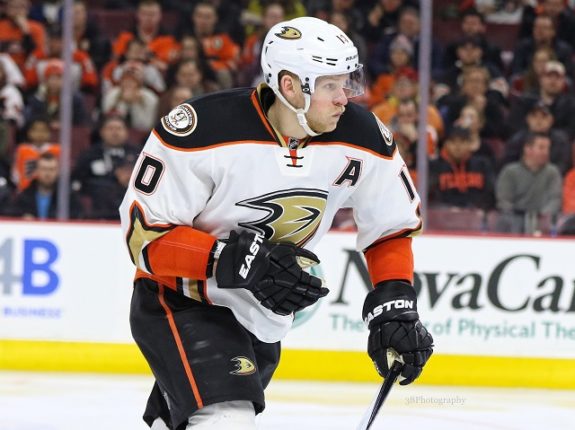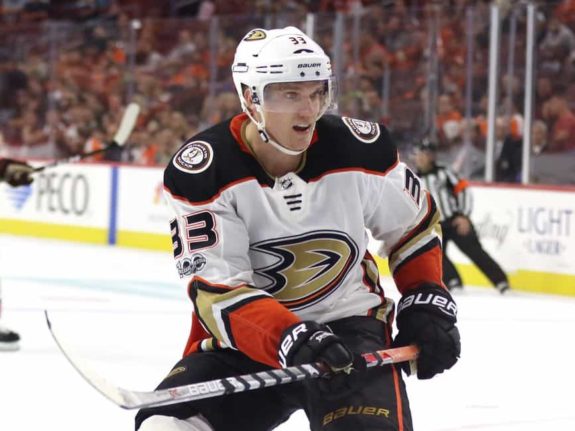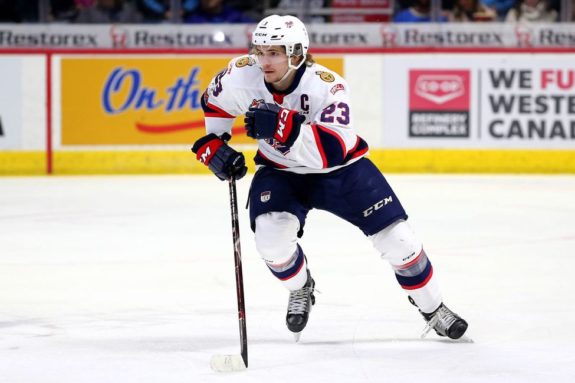A new season of NHL hockey is upon us and a familiar conundrum is facing the Anaheim Ducks. Does this team have the top-end forward talent to be an elite team?
The Ducks have consistently been a good team, having won the Pacific Division title in five of the last six years and ended last season with 101 points, despite injuries to key players. They’re still missing that extra gear, though, that could send them to the Stanley Cup Final. Their forward group has plenty of talent, so who’s lagging behind and who needs to step up?
Ducks That Need to Step Up
Corey Perry
Corey Perry’s shortcomings have been discussed ad nauseam this summer. The pace of the game is too fast for him and he’s well past his 50-goal season. That being said, Perry is a proud competitor and his poor showing last season can’t be sitting calmly in his mind.

Ryan Getzlaf recently talked to Eric Stephens of The Athletic and broached the topic of the quickening pace of the NHL. “Playing fast doesn’t mean you have to skate fast. It means you move the puck quickly…The speed of the game is based on you moving the puck,” (from ‘Q&A with Ryan Getzlaf, Part I: On his charity golf tournament, playing fast, Kesler’s health and Perry’s production’ The AthleticNHL – 9/7/18).
What Getzlaf says is true. Perry needs to move the puck quickly rather than think he can hold onto it for any length of time. Although his goal totals have gone down, his assists have remained fairly consistent. Last season he produced assists at a rate of 1.5 assists per 60 minutes (A/60) and produced primary assists at a rate of 1.0 per 60 minutes. The only Ducks player who produced more assists per 60 minutes last season was Getzlaf at a rate of 2.5 A/60.
Perry can still be effective at the NHL level but his goal production isn’t there anymore. He’ll have to adjust his game in a way that compliments the game’s quickening pace. Otherwise he’ll end up being another washed up and overpaid star that a team might be looking to do away with.
Jakob Silfverberg
Silfverberg has always been a strong 200-foot player, but his offensive game leaves something to be desired. He is skilled and has a wicked wrist shot but when he’s in the offensive zone, he cycles the puck with Andrew Cogliano and Ryan Kesler rather than using his shot.
There’s something to be said for keeping the puck away from the opponent’s top talent, but even that wasn’t the case last season as he had a down year possessing the puck as well. Silfverberg finished with a Corsi percentage of 48.9%, the first time in his career he was below 50%.

Forty points for a second-line forward isn’t going to cut it in today’s NHL. The Ducks’ second line needs to drive the offense more. Silfverberg also lagged in shootouts last season, something he had excelled at in previous seasons, with zero goals in five attempts. He is a strong player and key to the team’s forward depth, but he needs to play better than he did last season.
Nick Ritchie
This could be a make-or-break year for the power forward. He hasn’t lived up to the hype of a 10th-overall draft pick (2014), but he has all the tools to be a solid NHL player. At 6-foot-2 and 230 pounds, Ritchie has the frame for the league. He is also a strong skater for his size and has an underutilized wrist shot. The flip side is that he takes undisciplined penalties and still hasn’t scored more than 30 points in a season since he entered the league in 2015-16.
At 22-years old, he’s young and his best years are in front of him. With Ducks’ forward core getting older, it’s a prime year for Ritchie to step up and take the reins offensively. Whether that happens or not is up to him. Then again, his performance also depends on coming to an agreement with management on a new contract. Zach Stava wrote about Nick Ritchie and the deal he is likely to sign with the club as an RFA currently without a contract.
Rookies That Could Impact the Team
The Ducks have a decent prospect pool but the forward prospects have yet to stand out and find a place at the NHL level. Which of these rookies is likely to step up and make an impact with the Ducks this season?
Sam Steel
Steel has been among the Ducks’ best prospects for the last few years now. He showed up for the Canadian Junior team and has had a stellar WHL career for the Regina Pats. He finished his WHL career with an MVP trophy in the Memorial Cup. Unfortunately, his Pats lost the trophy to Acadie-Bathurst in the finals.

Steel has the playmaking ability and the hockey IQ to compete in the NHL. The biggest lingering question is whether he has the size for it. He stands at 5-foot-11 and 185 pounds and could get pushed around until he bulks up.
Troy Terry
Terry is coming off a very successful career at the University of Denver where he ended as a point-per-game player and has done well for the US teams in international competition (World Junior and the Olympics). He’s a well-seasoned hockey player and looks ready to make the jump, however, like Steel, he has a slight frame for the NHL game. In his two games with the Ducks last season, his skill was evident but he was easily pushed off the puck. He is set up well to be an impact player in the NHL, but whether he lives up to that hype or not is in his hands now.
Isac Lundestrom
Lundestrom was drafted only this summer, but he made an impact in the rookie showcase in Las Vegas where he scored three goals in two games, leaving a marked impression on the Ducks organization. He’s penciled in to return to Lulea HF of the SHL for the season, but if Lundestrom can play well in the preseason, he may force general manager Bob Murray’s hand and get a chance at the NHL.
There’s no doubt that the Ducks playoff window is closing quickly. Whether it slams shut or remains ajar will depend on the ability of these forwards to play like a playoff team.